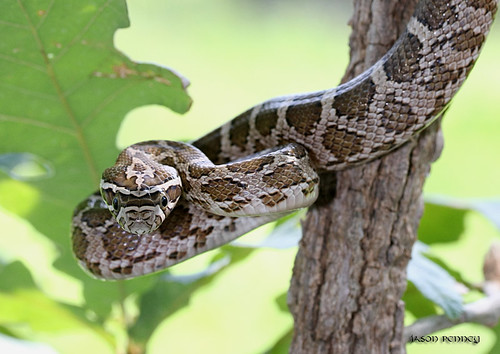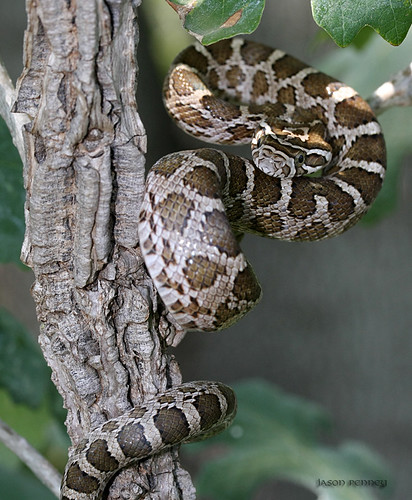The Great Plains Rat Snake (Pantherophis emoryi or Elaphe emoryi) is a species of non-venomous rat snake native to the eastern two thirds of the United States, from New Jersey to Nebraska, to Colorado, south to Texas, and into northern Mexico. It is a subspecies of the corn snake, which is commonly kept as a pet, and is sometimes interbred with the corn snake to produce varying pattern and color morphs.
The epithet emoryi is in honor of Brigadier General William Hemsley Emory, who was chief surveyor of the U.S. Boundary Survey team of 1852 and collected specimens for the Smithsonian Institution. As such, it is sometimes referred to as Emory's Rat Snake.
The Great Plains Rat Snake is typically light gray or tan in color, with dark gray, brown, or green-gray blotching down its back, and stripes on either side of the head which meet to form a point between the eyes. They are capable of growing from 24 to 42 inches in length.
The epithet emoryi is in honor of Brigadier General William Hemsley Emory, who was chief surveyor of the U.S. Boundary Survey team of 1852 and collected specimens for the Smithsonian Institution. As such, it is sometimes referred to as Emory's Rat Snake.
The Great Plains Rat Snake is typically light gray or tan in color, with dark gray, brown, or green-gray blotching down its back, and stripes on either side of the head which meet to form a point between the eyes. They are capable of growing from 24 to 42 inches in length.
Great Plains Rat Snakes prefer open grassland or lightly forested habitats, but are also found on coastal plains, semi-arid regions, as well as rocky, moderately mountainous regions. They can often be found on farmland, which often leads it to be erroneously called the chicken snake, and other areas with a relatively high rodent population, which is their primary diet. They will also eat birds, and occasionally snakes, lizards and frogs, all of which they subdue by constriction.
They are primarily nocturnal, and oviparous, laying clutches of as many as 25 eggs in the late spring. Like most rat snakes, when agitated, the Great Plains Rat Snake will shake its tail vigorously, which by itself makes no noise, but when it shakes amongst dry leaf litter, it can sound remarkably like a rattlesnake, and often leads to misidentification.
They are primarily nocturnal, and oviparous, laying clutches of as many as 25 eggs in the late spring. Like most rat snakes, when agitated, the Great Plains Rat Snake will shake its tail vigorously, which by itself makes no noise, but when it shakes amongst dry leaf litter, it can sound remarkably like a rattlesnake, and often leads to misidentification.



No comments:
Post a Comment